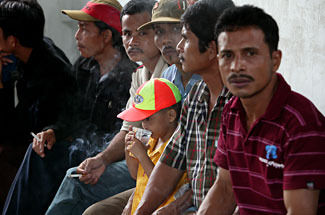WHO: 10 facts on the tobacco epidemic and its control
http://www.who.int/features/factfiles/tobacco_epidemic/en/index.html
Fact 1 흡연은 폐암, 심장병 등을 일으켜 년간 전 세계 540만명 죽여
The tobacco epidemic kills 5.4 million people a year from lung cancer, heart disease and other illnesses. Unchecked, that number will increase to more than eight million a year by 2030. Tobacco use is a risk factor for six of the eight leading causes of deaths in the world.
Fact 2 담배회사의 마케팅 전략으로 개도국에서 흡연 관련 사망 급증. (개도국 청소년 및 성인, 그리고 여성을 공략)
Tragically, the epidemic is shifting towards the developing world, where 80% of tobacco-related deaths will occur within a few decades. The shift is caused by a global tobacco industry marketing strategy that targets young people and adults in developing countries. In addition, because most women currently do not use tobacco, the tobacco industry aggressively reaches out to them to tap into this potential new market.
Fact 3 흡연 관련 사망은 인간에 의해 만들어졌으며, 예방 가능.(전 세계 5%의 인구만이 흡연을 효과적으로 통제하고 있는 나라에 살고 있음)
The tobacco epidemic is man-made and entirely preventable. Yet, only 5% of the world’s population lives in a country that fully protects its population with any one of the key policy interventions that have significantly reduced tobacco use in the countries that have implemented them.
Fact 4 흡연(the tobacco epidemic)을 줄이기 위한 WHO의 6대 전략 MPOWER
M: 흡연에 대한 감시(Monitoring)와 예방(Prevention)
P: 담배연기로부터 보호(Protecting)
O: 금연을 위한 도움을 제공(Offering help)
W: 흡연의 위험에 대한 경고(Warning)
E: 담배 광고와 판촉 및 담배회사의 후원을 법률적으로 금지함(Enforcing bans)
R: 담배에 대한 세금 인상(Raising taxes)

The six most effective policies that can curb the tobacco epidemic are outlined in WHO’s MPOWER strategy:
Monitoring tobacco use and prevention
Protecting people from tobacco smoke
Offering help to quit tobacco use
Warning people about the dangers of tobacco
Enforcing bans on tobacco advertising, promotion and sponsorship
Raising taxes on tobacco
Fact 5 M: 흡연에 대한 감시(Monitoring)와 예방(Prevention)
MPOWER policy 1: monitoring tobacco use and prevention
Assessment of tobacco use and its impact must be strengthened. Currently, half of the countries in the world – two out of three in the developing world – do not have even minimal data about youth and adult tobacco use.
Fact 6 P: 담배연기로부터 보호(Protecting)
MPOWER policy 2: protecting people from tobacco smoke
More than half of countries worldwide, accounting for nearly two thirds of the population of the world, allow smoking in government offices, work spaces and other indoor settings. Smoke-free policies in the workplaces of several industrialized nations have reduced total tobacco consumption among employees by an average of 29%.
Fact 7 O: 금연을 위한 도움을 제공(Offering help)
MPOWER policy 3: offering help to quit tobacco use
Among smokers who are aware of the dangers of tobacco, three out of four want to quit. Comprehensive services to treat tobacco dependence are available to only 5% of the world’s population. It is difficult for tobacco users to quit on their own and most people benefit from help and support to overcome their dependence. Countries’ health-care systems hold the primary responsibility for treating tobacco dependence.
Fact 8 W: 흡연의 위험에 대한 경고(Warning)
MPOWER policy 4: warning about the dangers of tobacco
Graphic warnings on tobacco product packaging deter tobacco use, yet only 15 countries, representing 6% of the world’s population, mandate pictorial warnings that cover at least 30% of the principal surface area.
More than 40% of the world’s population live in countries that do not prevent the use of misleading and deceptive packaging terms such as “light” and “low-tar” – none of which actually signify any reduction in health risk.
Fact 9 E: 담배 광고와 판촉 및 담배회사의 후원을 법률적으로 금지함(Enforcing bans)
MPOWER policy 5: enforcing bans on tobacco advertising, promotion and sponsorship
About half of the children of the world live in countries that do not ban free distribution of tobacco products. National-level studies before and after advertising bans found a decline in tobacco consumption of up to 16% following prohibitions.
Fact 10 R: 담배에 대한 세금 인상(Raising taxes)
MPOWER policy 6: raising taxes on tobacco products
Increasing tobacco taxes by 10% generally decreases tobacco consumption by 4% in high-income countries and by about 8% in low- and middle-income countries. A 70% increase in the price of tobacco would prevent up to a quarter of all tobacco-related deaths among today’s smokers.








